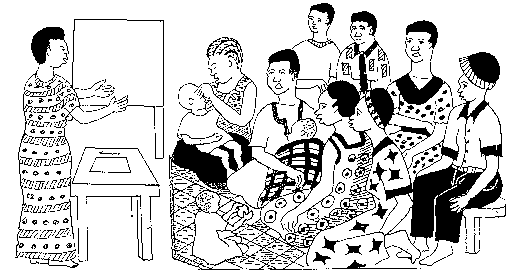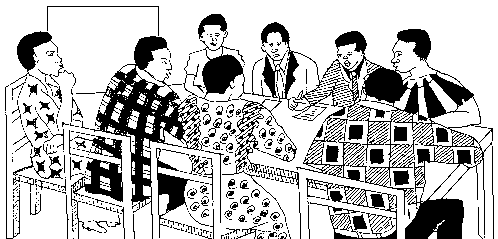Tweet
Translations:
Other Pages:
Modules
Site Map
Key Words
Contact
Utility Documents
Useful Links
Contents:
Contents:
Contents:
Contents:
CHAPTER TWO
Training for Action
Training for Strength; A Community Management Training Methodology
by Phil Bartle, PhD
2. Training for Action:
If you want to learn something for the sake of learning it, go to a philosophy professor at the university. Our reason for training is to produce certain actions. There are no examinations; the test of its effectiveness is the action that results. The test of our training effectiveness is the degree to which the target communities are strengthened (capacities increased, self reliance improved). An indicator of that increased strength is that the community organizes to engage in self help actions.
Our purpose of training is six fold:
- Awareness raising (there is a problem);
- Information imparting (but there is a solution);
- Skill acquisition (how to solve the problem);
- Encouragement (take courage; do it);
and, most importantly,
- Organizing (Effective organization)
- Mobilization (Action).
We can justify our training only from the community action that results from it.
2.1. Community Participation, Animation and Management:
Social Animation promotes the activities of a target community, with a view to the community taking more responsibility for its own development, starting with decisions about what projects to undertake, and stimulation to mobilize resources and organize activities.
Community Participation Promotion aims at ensuring that decisions affecting the community are taken by all (not only a few) community members (not by an outside agency).
Community Management takes these two endeavours a logical step further by training community members and leaders in management techniques needed to ensure the community takes control of its own development. It also encourages and trains Government officials and community leaders to abandon the patronizing role of providing facilities and services. They must facilitate communities to identify resources and undertake actions to provide and maintain human settlement facilities and services. Management training, as well as transferring skills to individuals, is used to organize and or re-organize for increased capacity.
Illustration 3: Community Meeting;
Deciding Priorities:
 |
2.2. Awareness Raising and Mobilization:
All the above, animation, promoting community participation, and community management training, involve two important elements:
- (a) awareness raising, then
- (b) mobilization.
The community members must discover that not only are there some problems faced by the whole community, but also that the whole community has the potential and (often hidden) resources to solve each problem.
Awareness raising includes demonstrating to the community that the solutions to community problems, to be most effective, must include the involvement of those who were often overlooked in the past, eg vulnerable persons, including disabled, both men and women, all minorities and powerless, low income groups, and must be ecologically sound, realistic and practical. In deciding on what actions (or projects) to undertake, and planning how to do so, the communities must identify resources, both internal and external. This must be thorough, not superficial, and might take place over some time.
Resources include labour (paid, voluntary, communal, etc.), land (space on which to carry out the activity), transport, tools and other capital, finance, organizing, planning, management and everything needed to carry out the chosen objectives. Putting them in place at the right time in the right amount (activating those resources) is the purpose of mobilization.
Awareness raising and mobilization do not mean making speeches to harangue community members or to unrealistically raise their expectations. Trainers and facilitators must take care to avoid raising unrealistic expectations.
(Say, "We make no promises.")
––»«––
Illustration 4: Community Organization's Executive Meeting;
Planning a Project:
 |
Note: To copy or download each image from its URL, right-click on it and choose the "Save_Picture_As" option in the pull-down menu. Also see Community Strengthening Cycle Illustrations , Disaster Illustratons, Income Generation Illustrations and Extra Illustrations for complete sets with no text. You can down load the illustrations from there for producing your own training material.
- Introduction:
Training For Strength - Chapter One:
Introducing Management Training for Communities - Chapter Two:
Training for Community Action - Chapter Three:
Management Training to Empower Communities - Chapter Four:
Training in Community Management Programme - Chapter Five:
Some Players in the Strengthening Methodology - Chapter Six:
Some Other Essential Training Topics